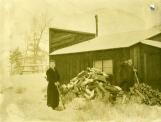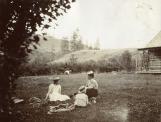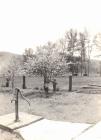14
The Many Warms in WoodPull up a chair beside the heat
Or stand and warm your back and seat
And come with me down memory lane
When saws lacked motors or a chain
When all our fuel was cut from logs
For cooling, heating and scalding hogs
From early youth we understood
The many warms there were in wood
First we took a crosscut saw
Cut down a tree and watched with awe
As slowly gaining speed it fell
We sawed off logs, got warm as well.
With horses sweating and teamster too
The logs were skidded a mile or two
And when old Maud balked as she used to do
The air around turned a smoky blue.
A horse powered saw sat near our home
But it wouldn't do the work alone
Someone had to drive the team
Going around and around soon raised some steam.
Blocks of wood had to be carried away
Stored in the shed for another day
A warming job when your weight you pull
But satisfying when it was full.
Then every day before it was night
A sweat was raised splitting it right
The wood box had to be filled to the top
That chore sure kept you on the hop
If the wood in the boxes ever ran out
You'd hear Ma yell "Where is that lout?
I'm out of wood" you'd hear her holler
Sure made her hot under the collar
By the old woodstove of a winters morn
We clustered around to get warm
In evening again as the cold crept in
It was the centre of warmth for friends and kin
Now all these warms as sure as fate
Has caused the wood to dissipate
For the woodshed empty so it is plain
We'll have to get more wood again.
- Verdun T. Casselman
15
Keeping up with winter weatherCirca 1915
Midway, BC
 Credits:
Credits:Kettle River Mueum
Donated by Nora Eveleth, 1978
16
Mrs. Lander and Mrs. Horridge by the orchard at the Davis placeCirca 1910
Benchlands of the Kettle River Valley
 Credits:
Credits:Kettle River Museum
Donated by Nora Eveleth, 1978
17
Applecross"On July 15, 1909, we arrived at Midway, the then terminus of the [Columbia & Western Railway] and were driven to Rock Creek in the stage. Tom Hanson himself drove the four-in-hand at a great clip 'round the curves of the narrow road, all the harness bells jangling. Early in August my parents moved from the Riverside Hotel into two tents on the riverbank. Their intention was to buy some acres of 'irrigated fruit land' from the 'Kettle Valley Irrigated Fruit Lands Co.' and to build. We were the first of a small group of retired army and navy officers who soon came to live in the valley...
The soil was sandy, the total annual precipitation about twelve inches or so. Irrigation water was brought all the way from a dam in Rock Creek, and for some of the distance in an open ditch. There was, of course, no electricity so water could not be pumped from the river. I have found a note in one of my father's diaries of what he paid for land. He bought just under twenty-three acres on the far side of the valley from the river. It may serve as an index to the nature of the whole land deal... rough-cleared, unfenced, and only about two-thirds of it could ever be irrigated. The average cost per acre was $145... a fantastically high price.
My father named our place Applecross.
During the next five years my parents worked very hard. With little outside help my father manured, ploughed and harrowed the land. Some was planted in alfalfa, some in vegetables and small fruit, but the main effort was to get the young apple trees started.
To us, here and now, Major Anderson's daily work would not seem extraordinary - ploughing, cultivating, hauling water in a barrel on a "go-devil", caring for a team of horses, and other chores. But to anyone who knows the type of training and the life of an officer in a British regiment at the end of the 19th century, what my father learned to do and to enjoy doing is nothing short of a marvel. He was fifty when he began to learn..."
- from "Seven to Seventeen - 1909-19 in the Kettle Valley" by Anne Margaret Angus (Annie Margaret Anderson), Boundary Historical Society 5th Report, 1967
18
Orchard on Dominion StreetCirca 1920
Midway, BC
 Credits:
Credits:Kettle River Museum
Donated by Nora Eveleth
19
"...On January 7, 1915 the War Office telegram my father had been expecting arrived. He was to return to duty. The next six days were occupied in turning over the Irrigation Company accounts to Colonel Walter Glossop, seeing to things about the place for my mother, and arranging for his transportation to Britain. My father's diary ends with the entry for January 12, 1915. It is continued in my mother's handwriting. Her entry for Tuesday, October 26, 1915 reads, "Our wedding anniversary. Mr. Jackson and the Kerrs brought me the cablegram telling of my beloved husband's death." My father was killed in action on October 19, 1915 in Gallipolis. He was then fifty-five.It was in 1916 that mother harvested our first, and last, apple crop. She notes that at the time she had about nine and a half acres in orchard. It was a good crop. My mother picked, wrapped and packed the apples and hauled them to the (railway) siding.
The winter of 1917-18 was a deadly one, and nearly all the apple trees in the valley were killed. All ours were. Kettle Valley was a frost pocket and should never have been planted in orchards. The death of my father and of several dear friends overshadowed the other loss... my mother decided to abandon Applecrross in the summer of 19119 and move to Vancouver.
Once or twice since then I have travelled the fine road that now goes through the valley which was my home from the age of seven to seventeen. It is for me a haunted place full of vivid childhood memories and a more vivid sorrow."
- from "Seven to Seventeen - 1909-19 in the Kettle Valley" by Anne Margaret Angus (Annie Margaret Anderson), Boundary Historical Society 5th Report, 1967
21
The Jackson RanchCirca 1930
The Kettle River Valley
 Credits:
Credits:Kettle River Museum
Donated by Nora Eveleth, 1979
22
"The first houses and other farm building were built of logs, and when sawmills were in operation later on, frame buildings were constructed. These frame houses were invariably two-story with basements and many of these house are still standing today with the probability of many more years of useful shelter.The barns for the stabling of horses and milk cows, and also for the storage of hay, were built by volunteer labour composed of neighbours, and a master carpenter was in charge of the operation. These carpenters were expert in planning and erecting these buildings with built-in granaries as well. Few nails or metal of any kind were used in construction, and where beams and braces were joined together this was done with wooden pegs in drilled holes."
- from "A Harvest of Memories" by Bill Hatton, 1985
23
Dorothy and Johnnie under an apple tree at the Jackson RanchCirca 1930
The Kettle River Valley
 Credits:
Credits:Kettle River Museum
Donated by Nora Eveleth, 1979
